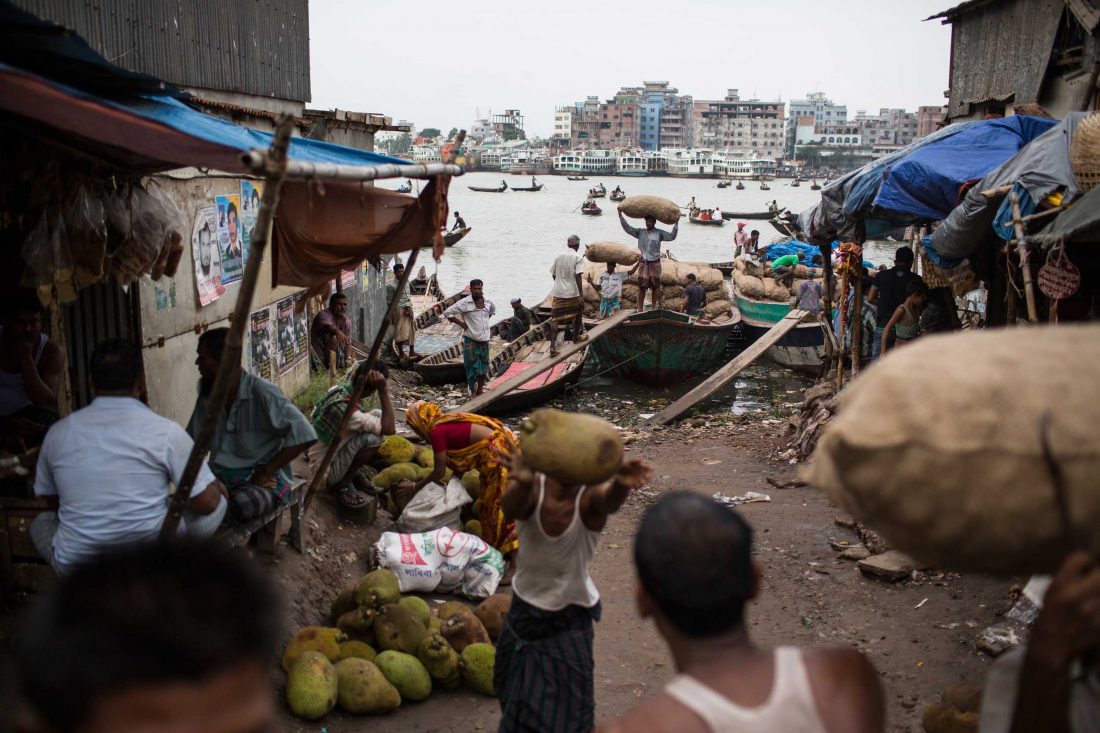By Aditya Valiathan Pillai
The Bangladesh-India relationship serves as the fulcrum for cooperation in the larger Bangladesh-Bhutan-India-Nepal (BBIN) sub-region, an experiment in restoring links between economies segmented by arbitrary borders at the birth of modern South Asia over seven decades ago. This grouping sees connectivity and trade as central to the prosperity of their large populations. A landmark agreement allowing for the movement of vehicles across those borders, signed two years ago, was the first concrete demonstration of its potential. Over the coming decade, this regional architecture could spur progress on energy grid integration, trade, and management of its shared rivers. In the broader geopolitical context, it is a strategic attempt to find an alternative to the South Asian Association for Regional Cooperation (SAARC), which has struggled to gain traction since its inception in 1985.

A market along the Buringanga River in Dhaka. Greater connectively in South Asia via a proposed waterway trade agenda could lower costs and spur collaboration. South Photo/Conor Ashleigh
A proposed inland waterway trade agenda is particularly promising. Trade over inland waterways between the two countries is governed by a protocol agreement that was first signed in 1972 but required periodic negotiations and renewals to remain functional. In 2015, Bangladesh and India agreed to automatic renewals, creating a more stable framework for trade. A year later, a vessel travelled across Bangladesh from the Indian city of Kolkata to its northeastern state of Tripura. The free movement of cargo along the Ganga and Brahmaputra, supplemented by last-mile road and coastal shipping connectivity, would give the long-isolated markets of northeast India access to the industrial centers of north India and Bangladesh. Bangladesh will find it easier to sell its garments, pharmaceuticals, and leather to India, Bhutan, and possibly Nepal. Landlocked Nepal and Bhutan, in turn, would finally have an easy route to the sea through downstream Bangladesh; exports could stimulate economic growth while greater supply could help keep a lid on inflation (if regional tariff structures and non-tariff barriers fall in line).
The waterway would also reduce transport costs in the region—the Indian shipping ministry estimates that it would take 10 times less money to move cargo a kilometer by river than by road, which is currently the mode of choice for almost all trade in the region. Waterway transport also uses about a fifth of the fuel road transport does, which could mean substantial carbon emission reductions.
Since the change of government in the 2014 general election, the Indian government has loosened purse strings for investment in 111 national waterways (up from five prior to a new waterway act in 2016), allowed for more predictable terms of engagement with Bangladesh through the revamped protocol agreement, and put in place an important MoU on bilateral coastal shipping to supplement waterway trade.
The agenda could boost coordination on transboundary river management. Maintaining navigability could lead to better coordination between the BBIN countries on planning where river infrastructure should be built, and how much water should flow down rivers and tributaries to ensure that ships can operate (especially since larger cargo ships will require significant depth to operate). This basic requirement of flowing water to the sea will also force the issue of environmental flows, which are assured minimum river flows needed to meet the water requirements of river ecosystems. Currently, countries in the region utilize the waters of transboundary rivers within their territories to meet their own ends (such as hydropower, flood control, and irrigation). Trading on these rivers introduces a shared cooperation benefit to the equation, incentivizing joint planning. If producers, consumers, tour operators, and environmentalists begin to see the benefits, governments might be more inclined to focus on seeing the basin as whole, and planning development together with neighbors.
However, there are three important issues that need to be addressed before inland waterway trade can take off. First, most of the regulatory framework that will govern waterway trade is not yet built. Civil society, communities, and governments at the local, provincial, and national levels must work together to decide which issues to prioritize as the framework emerges. The Asia Foundation is supporting a consortium of local organizations (Consumer Unity and Trust Society in India; South Asia Watch on Trade, Environment and Economics in Nepal; Unnayan Shammanay in Bangladesh; and the Royal Society for the Protection of Nature in Bhutan) to work with governments to improve the governance of inland waterways. Plugging gaps in policy to create a stable, comprehensive policy base for trade growth will signal stability and build confidence in the private sector, whose investments and participation will be critical to whether the enterprise succeeds.
Second, to meet the environmentally friendly commitments that the inland waterway trade agenda aspires to, regulatory attention must be paid to the type of fuel used in ships (most of which are not yet built). Incentivizing the use of Liquid Natural Gas over diesel could go a long way in this regard. In addition, prior thought should be given to the possibility of leaky cargo and malfunctioning barges that pollute the water.
Third, the livelihoods affected by opening these rivers to trade must be analyzed, as dredging the rivers for example will disturb existing ecosystems and change livelihood patterns for fishing-centric riverine communities. To this end, The Asia Foundation is supporting the International Union for Conservation of Nature (IUCN) to work with governments, communities, and civil society to draw up a roadmap for sustainable inland navigation and fisheries management.
In many ways, transboundary inland waterways are an enterprise in dismantling the irrationalities of history and boundaries to focus on the logic of geography. Getting it right will take time and dialogue between the many constituencies involved. If done right, it could be catalytic for South Asian regional integration.
Aditya Valiathan Pillai is a program officer for The Asia Foundation in India. The views and opinions expressed here are those of the author and not those of The Asia Foundation or its funders.
Reprinted with permission of the Asia Fiundation
